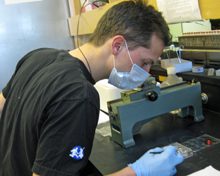Kyle Barbour L&S Sciences
Exploring seizure-like aberrations in the rat hippocampal mossy fiber pathway and medial prefrontal cortex following neonatal sevoflurane general anesthesia
Sevoflurane, a popular pediatric and veterinary general anesthetic, is known to cause deficits in learning and memory when administered to neonatal rodents. Since sevoflurane can trigger epileptiform activity when administered during development, and since neonatal epileptic seizures cause the formation of aberrant neural networks, it is possible that sevoflurane administered during development does the same. If present, this may contribute to the observed neurocognitive deficits. We will explore this possibility by retrovirally labeling the hippocampal mossy fiber pathway and medial prefrontal cortex in neonatal rats, then comparing the connections of these structures in rats given sevoflurane anesthesia to controls under a microscope. As sevoflurane may affect neuroblasts differently than more mature neurons, we will label these cell populations separately. With time, the results of this project may be relevant to the use of sevoflurane in animal anesthesia and possibly even to clinical pediatric anesthesia, as well as in guiding future research.
Message To Sponsor
The SURF grant has given me the incredible opportunity to work full-time as a neurobiologist in a fantastic research laboratory in one of the top medical research institutions in the world, the University of California, San Francisco. This has allowed me to experience the life of a working research scientist, tackle a difficult and fascinating problem, learn new research methods, and most importantly, have the experience of developing, managing, and driving a research project to completion.